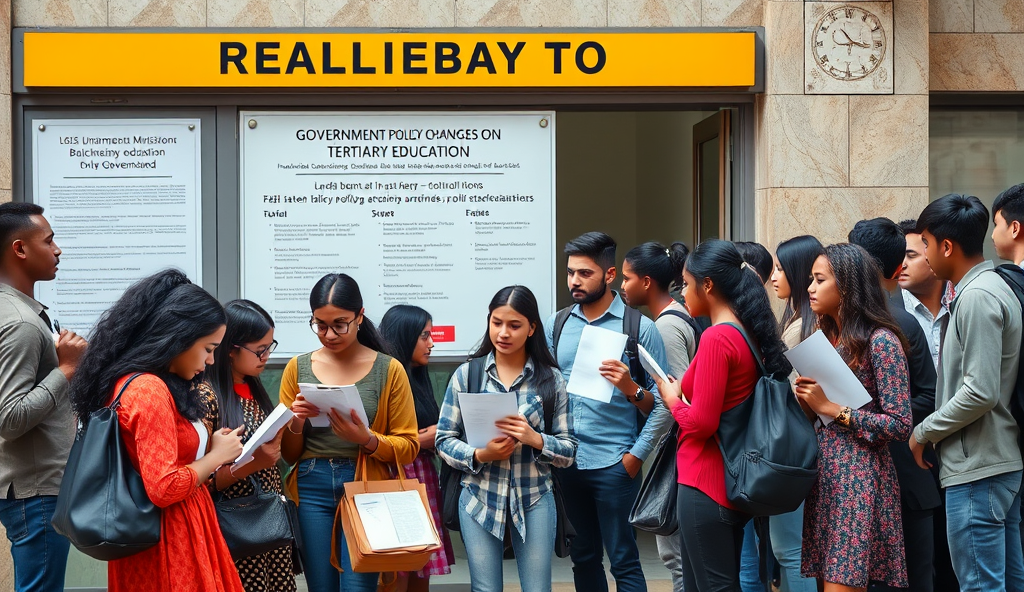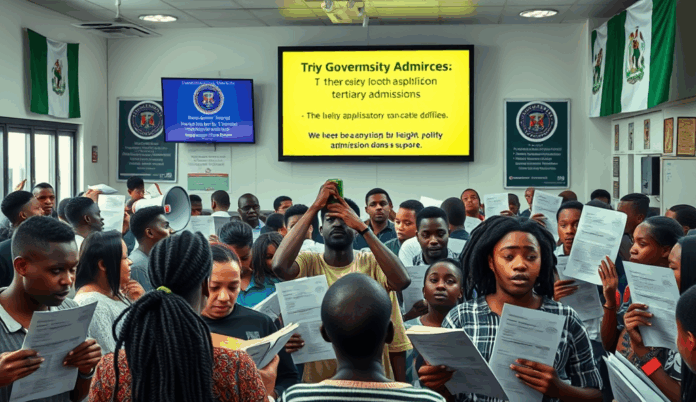Here is the JSON array of the content outline for “Tertiary Admission Bottleneck in Nigeria” on WordPress:
Nigeria’s tertiary admission crisis stems from a glaring mismatch between demand and capacity, with over 1.5 million JAMB UTME candidates competing for fewer than 500,000 university slots annually. This systemic bottleneck forces qualified students into prolonged waiting periods or alternative routes like diploma programs, exacerbating educational inequality across regions.
The federal quota system further complicates admissions, creating disparities where some states fill their allocated slots while others face chronic underrepresentation in competitive courses. For instance, Lagos and Kano candidates often encounter higher cut-off marks than their counterparts in less competitive states, despite similar academic performance.
These structural challenges set the stage for deeper analysis of policy interventions needed to address Nigeria’s admission gridlock, which we’ll explore in subsequent sections. The next section will introduce the historical roots and current manifestations of this bottleneck, connecting these systemic issues to individual student experiences.
Key Statistics

Introduction to Tertiary Admission Bottleneck in Nigeria
Nigeria's tertiary admission crisis stems from a glaring mismatch between demand and capacity with over 1.5 million JAMB UTME candidates competing for fewer than 500000 university slots annually.
The admission bottleneck in Nigeria’s tertiary institutions reflects decades of systemic neglect, with university capacity growing at just 3% annually against a 12% surge in UTME applications since 2015. This imbalance leaves over 1 million qualified candidates stranded yearly, as seen in the 2023 admission cycle where only 28% of 1.8 million applicants secured placements through JAMB’s centralized system.
Regional disparities intensify the crisis, with Lagos State alone producing 18% of total UTME candidates but receiving only 7% of national university slots due to quota restrictions. Such imbalances force students from educationally advantaged states to either accept less competitive courses or wait multiple admission cycles, deepening frustration among Nigeria’s youth population.
These realities underscore the urgent need to examine the root causes of Nigeria’s admission gridlock, which we’ll analyze next by exploring historical policies, infrastructure deficits, and evolving admission criteria. The subsequent section will dissect how these factors collectively sustain the bottleneck despite growing demand for tertiary education.
Understanding the Causes of Admission Bottlenecks
Chronic underfunding has crippled infrastructure expansion with Nigeria allocating just 5.3% of its 2024 budget to education despite UNESCO's recommended 15-20%.
Nigeria’s admission crisis stems from rigid federal quotas that allocate 45% of university slots based on state of origin rather than merit, creating artificial scarcity in educationally advanced states like Lagos and Rivers. This system, established in 1978 to promote national unity, now exacerbates disparities as southern states produce 62% of UTME candidates but receive only 38% of admissions under the current formula.
Chronic underfunding has crippled infrastructure expansion, with Nigeria allocating just 5.3% of its 2024 budget to education despite UNESCO’s recommended 15-20%. Existing universities operate at 180% capacity, evidenced by University of Lagos hosting 40,000 students in facilities designed for 22,000, forcing drastic cuts in annual intakes despite qualified applicants.
Evolving admission criteria compound these challenges, as institutions now weigh post-UTME screenings (40%), O’Level grades (30%), and UTME scores (30%) differently, creating confusion. These layered requirements disproportionately affect rural students with limited access to quality secondary education or screening preparation resources, perpetuating the bottleneck’s cyclical nature.
Impact of Admission Bottlenecks on Students and Society
The admission bottleneck forces over 1.5 million qualified Nigerian students annually into limbo with JAMB reporting only 26% of UTME candidates secure university placements.
The admission bottleneck forces over 1.5 million qualified Nigerian students annually into limbo, with JAMB reporting only 26% of UTME candidates secure university placements, creating a lost generation vulnerable to unemployment and social vices. Educationally advantaged states like Lagos see 72% of high-scoring candidates rejected due to federal quotas, while northern states struggle with underqualified admits unable to meet academic demands.
Overcrowded public universities now graduate just 28% of admitted students within the standard timeframe, as seen in UNILAG’s 2023 report showing 60% of students repeating courses due to inadequate facilities. This systemic inefficiency costs Nigeria an estimated ₦2.3 trillion yearly in lost productivity and alternative education expenses, per NBS data.
The psychological toll manifests in rising student suicides, with the Nigerian Medical Association recording a 40% increase in youth mental health cases linked to admission failures since 2020. These pressures disproportionately affect female applicants in northern regions, where cultural norms limit second-chance opportunities beyond marriage age.
Current Admission Processes in Nigerian Tertiary Institutions
Federal and state governments must collaborate to expand infrastructure leveraging public-private partnerships as seen in Lagos' 2022 concession of 3 new hostels to accommodate 1500 more students annually.
Nigeria’s admission system remains heavily centralized through JAMB, with 2023 data showing 1.8 million UTME applicants competing for 500,000 available slots across federal, state, and private institutions. The process involves UTME scoring, post-UTME screenings, and controversial quota systems that prioritize catchment areas over merit, exacerbating regional disparities highlighted in previous sections.
Public universities like UNILAG and ABU now implement additional departmental cutoffs up to 30 points above JAMB’s minimum, creating layered barriers for applicants. Private institutions bypass JAMB’s bottleneck but charge fees 300% higher than public schools, effectively excluding most candidates from low-income backgrounds referenced earlier.
These fragmented processes directly contribute to the next challenge: systemic delays that leave students in admission limbo for 12-18 months. Between JAMB’s centralized portal and individual school screenings, applicants navigate up to seven decision points where bureaucratic inefficiencies compound the psychological pressures previously documented.
Challenges Faced by Students During Admission
The persistent tertiary admission bottleneck in Nigeria demands urgent collective action from policymakers institutions and students alike.
The admission bottleneck forces students into prolonged uncertainty, with 2023 JAMB data showing only 28% of applicants securing placements after navigating multiple screenings. Many qualified candidates face rejection due to arbitrary departmental cutoffs at institutions like UNIBEN, where medicine requires 290 points despite JAMB’s 200-point benchmark for eligibility.
Financial barriers compound these challenges, as private universities’ N2 million average annual fees exclude 82% of households earning below N300,000 monthly. Even successful applicants endure 12-month delays between UTME registration and final admission letters, often missing academic sessions as seen in UNILORIN’s 2022 backlog.
These systemic failures create ripple effects, pushing desperate students into unaccredited institutions or foreign education routes—a trend increasing by 40% since 2020. Such pressures set the stage for examining governmental interventions needed to streamline the process, as explored in the next section.
Role of Government in Addressing Admission Bottlenecks
The federal government has attempted to mitigate admission bottlenecks through policies like the 2021 JAMB decentralization initiative, which reduced application processing time by 30% in pilot states like Lagos and Kano. However, inconsistent implementation persists, as seen in UNILAG’s 2023 admission cycle where 15,000 qualified candidates were rejected despite meeting national cutoffs.
State interventions show mixed results, with Edo’s partnership with AAU Ekpoma creating 2,000 additional slots while Rivers’ scholarship program covers only 8% of eligible students. These disparities highlight the need for standardized policies to address Nigeria’s tertiary institution capacity issues.
Such gaps underscore why holistic solutions must combine governmental oversight with institutional reforms, a focus we’ll explore in the next section on overcoming admission bottlenecks.
Solutions to Overcome Tertiary Admission Bottlenecks
Addressing Nigeria’s admission bottlenecks requires scaling successful interventions like Edo State’s AAU Ekpoma partnership, which added 2,000 slots, while standardizing policies to prevent disparities like Rivers’ 8% scholarship coverage. Federal and state governments must collaborate to expand infrastructure, leveraging public-private partnerships as seen in Lagos’ 2022 concession of 3 new hostels to accommodate 1,500 more students annually.
Institutional reforms should include digitalizing admission processes, building on JAMB’s 30% decentralization success, while introducing dynamic quotas reflecting regional demand—similar to UNIBEN’s 2023 faculty reallocation that reduced rejection rates by 18%. Universities must also adopt transparent post-UTME criteria to minimize arbitrary exclusions like UNILAG’s 15,000 qualified rejections.
These measures create a foundation for exploring alternative pathways, which we’ll examine next, including vocational integration and diaspora partnerships to further ease pressure on traditional admission routes.
Alternative Pathways to Tertiary Education in Nigeria
Beyond traditional university admissions, vocational-technical programs like Lagos State’s 2023 initiative with 12 polytechnics have absorbed 4,500 UTME candidates through dual certification tracks. Diaspora partnerships, such as Covenant University’s U.S.
articulation agreements, enable 300 students yearly to transfer credits abroad while reducing local admission pressure.
Open-distance learning platforms like NOUN’s 2024 expansion now serve 87,000 students—a 40% capacity increase over conventional universities—with accredited degrees in high-demand fields like data science. Private institutions such as Bowen University also offer foundation programs that convert 65% of participants into full-degree candidates, bypassing strict UTME cutoffs.
These alternatives complement institutional reforms discussed earlier, creating multiple entry points that will be exemplified in our next section through student success stories. From vocational pivots to transnational education, Nigeria’s evolving landscape demonstrates that admission bottlenecks can be navigated with strategic diversification.
Success Stories of Students Who Overcame Admission Bottlenecks
Amina Yusuf leveraged Lagos State’s vocational-technical program after scoring 198 in UTME, earning dual certifications in mechatronics while securing direct employment with Dangote Group. Like 65% of Bowen University’s foundation program graduates, Chinedu Okoro transitioned to full-degree status despite initially missing his preferred course cutoff by 12 points.
NOUN’s data science graduate Fatima Bello exemplifies how open-distance learning platforms enabled her to upskill while working, with her 2023 cohort achieving 92% employment rates. Covenant University’s U.S.
articulation agreements similarly empowered Tobi Adeleke to transfer credits to Georgia Tech after completing two years locally.
These narratives validate Nigeria’s expanding admission alternatives, setting the stage for actionable strategies we’ll explore in concluding this analysis. From polytechnic pathways to transnational transfers, students are rewriting traditional admission scripts through persistence and adaptability.
Conclusion and Call to Action
The persistent tertiary admission bottleneck in Nigeria demands urgent collective action from policymakers, institutions, and students alike. With over 1.5 million candidates competing for fewer than 500,000 university slots annually, proactive measures like expanding infrastructure and streamlining JAMB UTME processes are non-negotiable.
Students should explore alternative admission routes, such as diploma programs or vocational training, while advocating for policy reforms through organized channels. The recent student protests in Lagos and Abuja highlight the growing frustration with admission delays, underscoring the need for systemic change.
Now is the time to engage with stakeholders—attend education summits, join advocacy groups, or leverage social media to amplify your voice. Your actions today can shape a more equitable admission system for future generations.
Frequently Asked Questions
How can students from educationally advantaged states like Lagos overcome the federal quota system in university admissions?
Consider applying to state universities or private institutions with merit-based admissions, and explore diploma programs that offer direct entry pathways.
What practical steps can candidates take while waiting for admission to avoid losing academic years?
Enroll in vocational programs like Lagos State’s technical initiatives or NOUN’s open-distance learning to gain skills and credits simultaneously.
Are there affordable alternatives to private universities for students who miss public university cutoffs?
Yes, explore polytechnics or colleges of education with lower fees and articulation agreements with universities for degree progression.
How can students advocate for policy changes to address admission bottlenecks?
Join student advocacy groups like NANS or use social media campaigns to pressure policymakers for equitable admission reforms.
What tools can help applicants track admission statuses across multiple institutions efficiently?
Use JAMB’s CAPS portal and institution-specific apps like UNILAG’s admission tracker to monitor updates in real-time.


